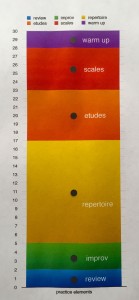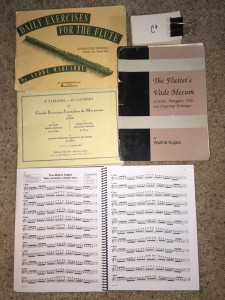Practice Session, part 2: Scales & Technique
- Marlene
- Blog, flute, Uncategorized
- 3 Comments
Practice Session, part 2: Scales & Technique
Scales and Technique
The second of the six parts of a practice session.
In the first blog post of this seven part series, I gave a general overview the elements of typical practice session:
- Warm up.
- Scales, short technical exercises.
- Etudes.
- Repertoire.
- Improvisation and revisiting old material.
- Review, warm-down, reflecting on goals and planning for the next practice session.
If we think of the practice session as a set of drawers, we start at the top and work our way down. Today, we will look in the second drawer: scales and technique exercises.
Opening the second drawer, we find lots of scale books, technique exercises, and things of that nature. This is minute 3-8 of our thirty minute practice session. In this part of the practice session, you will want to focus on short technical exercises. Ideally, you will choose exercises that strengthen your weaknesses and solve problems you are having in repertoire (element #4). When creating your plan for the practice session (element #1), try to pick exercises that will help you achieve your goals. These are a few of the books–and the scale cards–that I use during this portion of my practice:
Scales. There are many different kinds of scales– major, minor, chromatic, modes, whole tone, jazz, pentatonic, and so forth. Work on memorizing the scales. Check out the Scale Game I use with my students. Advanced players will also want to practice scales in thirds, octaves, full range, descending first (then ascending), and any other combination you can think of.
Intervals. Each instrument will have unique needs for interval practice, but we all benefit from working on difficult combinations of notes. I like to use an exercise of expanding intervals to increase flexibility. Lip slurs are great for brass players. All wind players can work on the harmonic/overtone series.
Articulations. Practice different kinds of accents, like marcato, staccato, legato. Work on the beginnings of notes. Don’t forget about articulations: single, double, and triple tonguing. Pianists may use exercises to improve their repetition speed and pedaling.
In a 30 minute practice session, you may want to spend about 5 minutes on scales and technical exercises. The technical exercises should be short. This will keep the brain entertained. Keep in mind the technical problems you have in your repertoire and pick scales and technical exercises that compliment that work. This is called “interleaving.”
Interleaving: That’s a cognitive science word, and it simply means mixing related but distinct material during study. –From How We Learn by Benedict Carey.
Choosing scales and technique exercises that are related to the repertoire you’re studying actually makes it easier. That’s really the whole point of scales and technical exercises anyway.
Longer exercises, or etudes, will be included in the next phase of practice. The two purposes of this phase of practice are
- strengthen skills needed in the solo repertoire
- prepare the body and mind for the longer, intense concentration needed for the longer pieces
Fingers flying, mind roaring, let’s move on to ETUDES.

3 comments